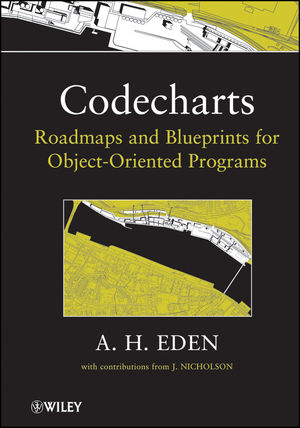Codecharts: Roadmaps and blueprints for object-oriented programsISBN: 978-0-470-62694-8
Hardcover
272 pages
May 2011
 |
||||||
Acknowledgements.
Guide to the Reader.
Codecharts.
Propositions.
Prologue.
1. Motivation.
2. Design Description Languages.
2.1 Theory Versus Practice.
2.2 Decidability.
2.3 Abstraction.
2.4 Elegance.
3. An Overview of Codecharts.
3.1 Object-Orientation.
3.2 Visualization.
3.3 Rigour.
3.4 Automated Verifiability.
3.5 Scalability.
3.6 Genericity.
3.7 Minimality.
3.8 Information Neglect.
4. UML Versus Codecharts.
5. Historical Notes.
PART I: Practice.
6. Modelling Small Programs.
6.1 Modelling Individual Classes.
6.2 Modelling Individual Methods.
6.3 Modelling Properties.
6.4 Modelling Implementation Minutia.
6.5 Modelling Simple Relations.
6.6 Modelling Indirect Relations.
6.7 Subtyping.
7. Modelling Large Programs.
7.1 Modelling Sets of Classes.
7.2 Modelling Total Relations Between Sets.
7.3 Modelling Sets of Methods (Clans).
7.4 Modelling Isomorphic Relations.
7.5 Modelling Sets of Methods (Tribes).
7.6 Modelling Class Hierarchies.
7.7 Modelling Methods in Hierarchies.
7.8 Modelling Properties of Sets.
7.9 Case Study: Total Versus. Isomorphic.
7.10 Case Study: JDOM.
7.11 Case Study: Java 3D.
8. Modelling Industry-Scale Programs.
8.1 Modelling Sets of Hierarchies.
8.2 Modelling Sets of Sets of Methods (Clans).
8.3 Modelling Sets of Sets of Methods (Tribes).
8.4 Modelling Total Relations Revisited.
8.5 Modelling Isomorphic Relations Revisited.
9. Modelling Design Motifs.
10. Modelling Application Frameworks.
10.1 Case Study: Enterprise JavaBeans.
10.2 Case Study: JUnit.
11. Modelling Design Patterns.
11.1 Case Study: The Composite Pattern.
11.2 Case Study: The Iterator Pattern.
11.3 Case Study: The Factory Method Pattern.
11.4 Case Study: The Abstract Factory Pattern.
11.5 Concluding Remarks.
12. Modelling Early Design Revisited.
13. Advanced Modelling Techniques.
13.1 Ad Hoc Symbols.
13.2 Modelling Information Hiding.
PART II: Theory.
14. Abstract Semantics.
14.1 Finite Structures.
14.2 Abstract Semantics Functions.
14.3 Design Models.
14.4 Program Modelling Revisited.
15. Verification.
15.1 Verifying Closed Specifications.
15.2 Verifying Open Specifications.
15.3 Verifying Pattern Implementations.
15.4 Tool Support for Automated Verification.
16. Schemas.
17. LePUS3 in Classical Logic.
17.1 LePUS3 and Class-Z as First-Order Languages.
17.2 Specifications in the Predicate Logic.
17.3 The Axioms of Class-Based Programs.
18. Reasoning about Charts.
Appendix I: The Gang of Four Companion.
Appendix II: Formal Definitions.
Appendix III: UML Quick Reference.
References.
Index.



